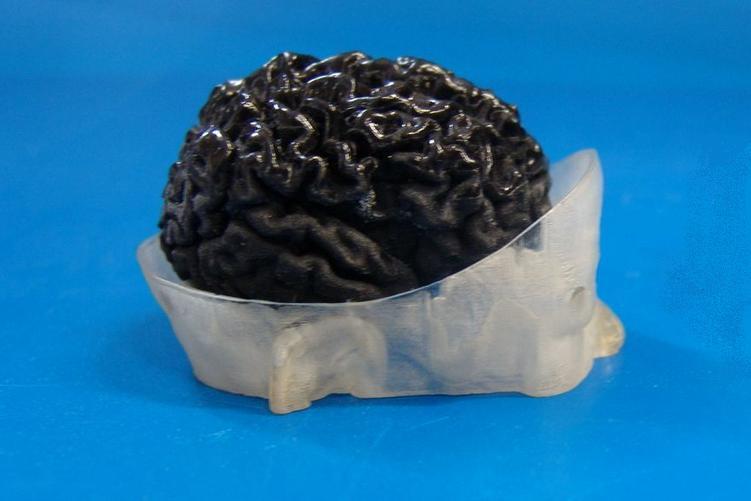
3D printed model of the child’s brain, by CTI (image provided to 3Dprint.com by Jorge Vicente Lopes da Silva)
The worse thing that parents could be told when their child is born with a potentially life altering birth defect, is that the condition presented is considered to be inoperable. Hopelessness begins to set in for the parents, as the excitement and joy of having a newborn suddenly turns into anger, and helplessness. After nine months of eagerly awaiting the birth of this already loved child, to learn that there is nothing that can be done to help him/her live a normal life can be extremely depressing.
We have already seen, in the past, where 3D printing has come to the aid of patients whose surgeons had previously believed their conditions to be inoperable. 3D printed models have seemingly become quite the tool for planning and performing complicated, intricate surgeries, that may not have been able to be performed, prior to this technology becoming available.
When it comes to 3D printing technology within the medical field, in Brazil, the Center for Information Technology Renato Archer (CTI) has really been at the forefront. More specifically, a man named Jorge Vicente Lopes da Silva, who is the chief of the Tridimensional Technologies Division at CTI, has be responsible for some amazing things.
“CTI is IT research center from the Science and Technology Ministry of Brazil, developing and integrating solutions for better surgical planning,” Silva explained to 3DPrint.com. “We have also many other applications like Egyptology, paleontology, etc. Also we developed an experimental technology for about 3500 cases with more than 100 hospitals in Brazil and some from Latin America.”
CTI’s technology has come to the aid of many patients in hospitals in South America, by providing 3D printed models for surgeons in complicated surgeries. Last week we reported on an instance, where CTI’s technology aided in the removal of a very large and unfortunately positioned tumor on a 12 year-old girl’s back. Today, we report on yet another surgery that was performed with the utilization of 3D printed models.
A baby in South America was born with Sturge-Weber Syndrome, a rare congenital neurological disorder that comes with many consequences. “The 3D technologies from CTI were used as a reference for (the) doctor to recognize complex structures and to plan surgery,” Silva told us.

3D scanned model of the child’s brain, by CTI (image provided to 3Dprint.com by Jorge Vicente Lopes da Silva)
For those of you unfamiliar with Sturge-Weber Syndrome, it is a disorder that effects usually one side of the brain, as well as the skin of its victim. The disorder is oftentimes associated with seizures, mental retardation, glaucoma, cerebral malformations and tumors, as well as its trademark “port-wine stains” of the face. A malformation of blood vessels usually occurs on one side of the brain, which causes calcification of brain tissue, and loss of nerve cells located in the cerebral cortex.
Children born with the disease have a very high chance of developmental delays and in some cases the development of mental retardation. Many of the symptoms develop as a child gets older, thus if there is a way to correct the disorder early, many of the symptoms may be minimized.

3D printed model of the child’s brain, by CTI (image provided to 3Dprint.com by Jorge Vicente Lopes da Silva)
Dr. Hélio Rubens Machado, a neurosurgeon at the Medical School of the University of São Paulo in the city of Ribeirão Preto (FMRP-USP), in São Paulo, Brazil, was recently faced with quite the challenge, in performing surgery on a young child who was born with Sturge-Weber syndrome. With the help of CTI though, he was able to take a 3D scan of the child’s head and brain, and then 3D print it out to use as a reference prior to, and during surgery.
The 3D print enabled Dr. Machado, to perform a successful surgery, because of the detailed tangible replica he had to work with. This is just one more way that 3D printing has aided in and allowed for a successful surgery within the medical field. This technology has only been available for several years, and we are beginning to see a more mainstream use for it among surgeons. It should be interesting to see how much more advanced this technology becomes over the course of the next few years.

3D printed model of the child’s brain, by CTI (image provided to 3Dprint.com by Jorge Vicente Lopes da Silva)
What do you think about the wonderful benefits that these 3D printed models have been able to provide to surgeons? Discuss in the 3D Printed Brain Model forum thread on 3DPB.com.

3D printed model of the child’s brain, by CTI (image provided to 3Dprint.com by Jorge Vicente Lopes da Silva)
Subscribe to Our Email Newsletter
Stay up-to-date on all the latest news from the 3D printing industry and receive information and offers from third party vendors.
You May Also Like
Gorilla Sports GE’s First 3D Printed Titanium Cast
How do you help a gorilla with a broken arm? Sounds like the start of a bad joke a zookeeper might tell, but it’s an actual dilemma recently faced by...
Nylon 3D Printed Parts Made More Functional with Coatings & Colors
Parts 3D printed from polyamide (PA, Nylon) 12 using powder bed fusion (PBF) are a mainstay in the additive manufacturing (AM) industry. While post-finishing processes have improved the porosity of...
$25M to Back Sintavia’s Largest Expansion of Metal 3D Printing Capacity Since 2019
Sintavia, the digital manufacturing company specializing in mission-critical parts for strategic sectors, announced a $25 million investment to increase its production capacity, the largest expansion to its operations since 2019....
Velo3D Initiates Public Offering in a Bid to Strengthen Financial Foundations and Drive Future Growth
Velo3D (NYSE: VLD) has been among a number of publicly traded 3D printing firms that have attempted to weather the current macroeconomic climate. After posting a challenging financial report for 2023,...































